~ LordM Greek sale draft, 10/7/14
 lordmarcovan
Posts: 44,081 ✭✭✭✭✭
lordmarcovan
Posts: 44,081 ✭✭✭✭✭
Please make me your best offer. I have included my costs for your consideration. Offers below my cost will not automatically be rejected, but they will be put on a back burner until I see how my overall sales go. If stuff doesn't sell here, there's always eBay later. Likewise for swap offers. They aren't totally out of the question- for later- but cash offers take precedence for 
Calabria, Taras- silver obol, ca. 250 BC.
(My cost: $65.60) - because the seller gave me a discount- it was originally priced at $82.00, as I recall.
Obverse- kantharos, surrounded by (five) pellets.
Reverse- kantharos, surrounded by pellets.
11 mm, 0.4 g. Ex-Brian Bucklan (bargainbinancients.com), 5/22/2014.
With cabinet toning from an old collection.
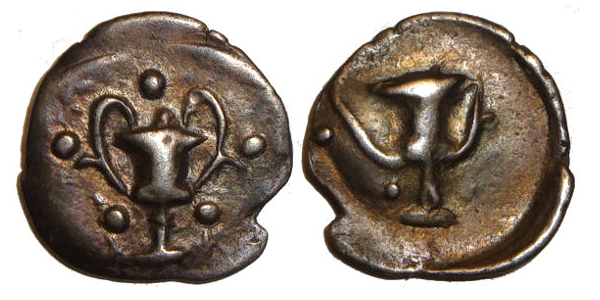
Coins of Calabria, Taras (Wildwinds)
Wikipedia links:
Taras (Tarentum, Taranto)
Kantharos (cantharus)
Kingdom of Macedon: bronze unit of Phillip II, ca. 359-336 BC
(My cost: $77.69) - 50 Euros plus shipping at the time
Obverse: head of Apollo right. Reverse: youth on horseback. Philip II was the father of Alexander the Great. Like the Akragas "crab" below, I bought this coin from Gitbud-Naumann in Germany back in May. Unfortunately G&N has deleted their listing and I never got around to looking up the attribution and doing a writeup for this. However, I used to own a very similar coin, albeit not as nice as this one, which has superior patina and eye appeal.
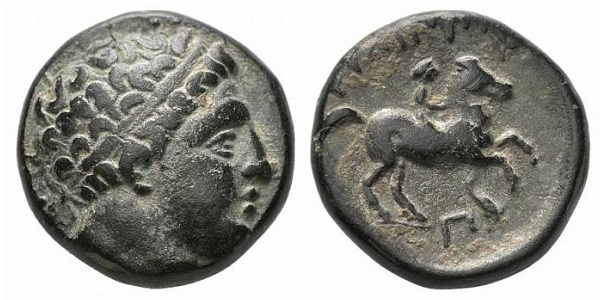
Ancient Greece: Seleucid Kingdom, bronze AE19 of Antiochus VIII, ca. 121-96 BC
(My cost: $110.00) - after slabbing
Obverse: radiate and diademed head of Antiochus VIII right.
Reverse: eagle standing left on thunderbolt, lotus-tipped scepter under right wing.
Struck ca. 121-120 BC, Antioch mint. 18.9 mm, 5.5-6.0 g approx. NGC VF (Strike 5/5, Surface 4/5, "sand patina"), cert.# 4094568-006. Ex-FORVM Ancient Coins, Lot# GB57125, July 2012. Purchased raw.
I love Seleucid coins for their combination of history, attractive designs, and relative affordability. The bronzes are often found with nice earthen or "desert" patina, and this coin in particular has very appealing patina with contrast to set off the design elements.
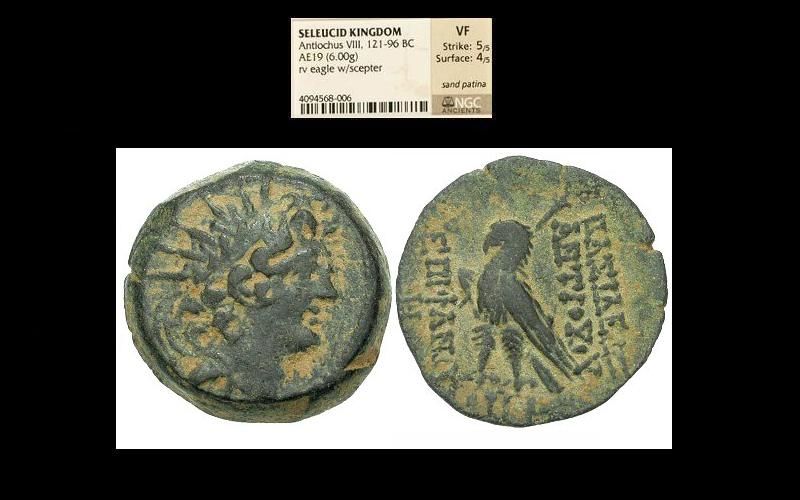
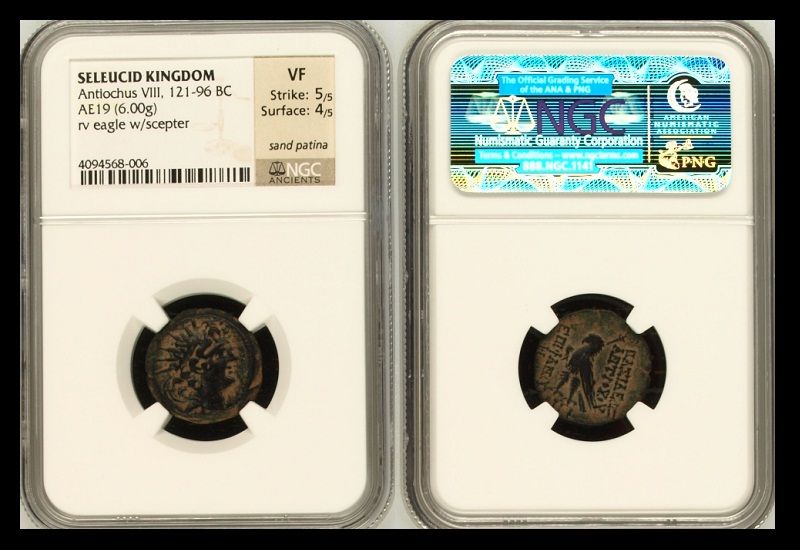
Original seller page
NGC cert verification page
Coins of Seleucia, Antiochus VIII (Wildwinds reference)
Wikipedia links:
Seleucid Empire
Antiochus VIII Grypus
Antioch on the Orontes
When posted here, this coin was part of my "Eclectic Box of 20" collection.
Sicily, Akragas: silver hemidrachm, ca. 410-406 BC
(My cost: $145.88) - 110 Euros plus shipping at the time
Obverse- eagle right, clutching dead hare in its talons, barley grain behind.
Reverse- Crab, with ketos below, swimming left with fish in its jaws.
16 mm, 1.8 g. SNG ANS 1012. Ex-Gitbud-Naumann, Germany, through VCoins store, 5/28/2014.
Eagles and hares! Crabs and sea monsters! Predators and prey! There is a lot going on with this wonderful ancient. I have always loved the Akragas "crabs" but can't afford one of the pricey big tetradrachms. And I actually like the design elements on this one more than some of those.
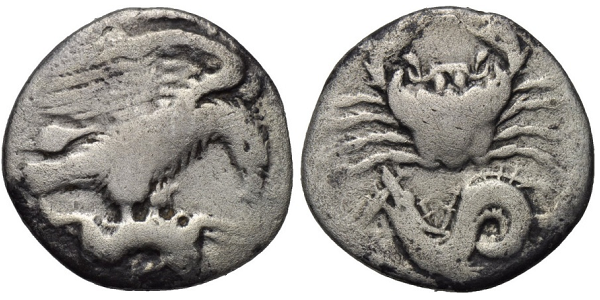
Slightly larger picture (900x450)
Coins of Sicily, Akragas (Wildwinds)
Wikipedia pages
Akragas (Agrigentum, Agrigento)
Ketos (cetus)
Troas, Birtytis: bronze AE8, ca. 300 BC
(My cost: $26.00) - and if you search these, I think you will find this was very cheap!
Obverse: bearded head of Kabeiros right, wearing conical hat.
Reverse: B-I/P-Y around club, all surrounded by laurel wreath.
8 mm, 1.1 g. Sandy/earthen patina. Ex- Andreas Reich ("areich" on FORVM ancient coins boards), Berlin, Germany. Sold to and later repurchased from "bronzemat" (Collectors Universe), 5/20/2014.
Birytis' precise location in Western Asia Minor is uncertain, but it probably stood either south of Troy or near the Hellespont (Dardanelles). Thus far, coins are the only surviving evidence of this city's existence.
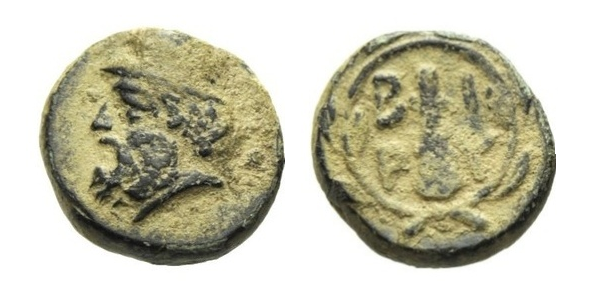
Coins of Troas, Birtytis (Wildwinds page)
Wikipedia links:
Troas (the Troad)
Kabeiros (the Cabeiri)
The following three came in a swap I did with NiceCurrency back in May. I never got around to researching or reimaging them. So the italicized quotes were copied and pasted from his descriptions at the time. We pulled the prices out of thin air, so being somewhat new to Greek coins, I don't know how they relate to the real market, but they seemed fair to me, particularly as ours was a straight swap with no cash involved. The Lydian siglos and the Aigina sea turtle are both very popular, very archaic coins of historical significance, I know that much. And even crude Aigina Turtles don't come cheap- they're usually several hundred dollars even when the coin is a blob with no head or fins on the turtle. This example is slightly porous, but the turtle's head and appendages are all there. So the price might have actually been pretty good; who knows.
Sardis, Lydia: silver siglos
(My cost: $100.00 in trade)


Quote from NiceCurrency:
<< <i>here is my info on a similar Sardis, Lydia siglos
Achaemenid (First Persian) Empire
AR Siglos
Sardis (Sart, Turkey) mint circa 490/480-475BC
14mm
5.37g
Obverse: Kneeling-running figure of the Great King (either Darius I or Xerxes I) facing right, transverse spear with point downward in right, bow in left, bearded, crowned.
Reverse: irregular oblong punch
This coin was possibly introduced in connection with the accession of Xerxes. (These are lighter in weight, but all Achaemenid sigloi have a very similar design)
Reference: Carradice Type IIIa >>
Aigina: silver "sea turtle" stater, the first European coin
(My cost: $300.00 in trade)



Quote from NiceCurrency:
<< <i>the turtle stater from aigina is one of the first ones as initially they depicted a sea turtle and then started to put some dots on it that weren't seen on the real animal, and then later when athens kicked their ass they went with the land tortoise
this is generally believed to be the first european coin, the first coin of course coming from modern day turkey >>
Istros, Thrace: silver drachm
(My cost; $100.00 in trade)


Quote from NiceCurrency:
<< <i>here is a copy and paste of my info on that thrace two headed deal, this was of a diobol, but same general idea on the drachm
Greek City of Istros, Thrace (Istria, Romania)
AR Diobol
Istros mint circa 400-350BC
10mm
0.8g
Obverse: Two facing male heads, one inverted
Reverse: Sea-eagle grasping a dolphin with its talons, IÓTPIH above (my guess is this translates to 'of the Istrosians' but I'm not certain) >>
And we'll wrap things up with a Roman. And a nicely patinated one at that. You can often find this great "desert" patina on Eastern mint coins from the Late Empire, but one doesn't see it so often on First century pieces of the Twelve Caesars era.
Ancient Rome (Imperial): bronze as of Claudius, ca. 41-54 AD
(My cost: $140.00) - after slabbing
Obverse- TI CLAVDIVS CAESAR AVG P M TR P IMP P P, bare head left.
Reverse- LIBERTAS AVGVSTA/ S-C, Libertas standing facing with pileus, extending left hand.
RIC 113, 28 mm, 9.03 g. NGC Choice Fine (Strike 3/5, Surface 3/5, "sand patina"), cert. #4094567-003. Ex-eBay, July 2011, purchased raw.
Claudius is known for leading the invasion of Britain in 43 AD. He is an interesting character. Probably much of that has to do with his fictionalization in Robert Graves' 1934 novel I, Claudius, which was later made into an excellent BBC television adaptation in 1976. I can remember watching the show then (I had just begun collecting coins), but a lot of it went over my young head at the time, as I had no knowledge of Roman history. I'd love to rewatch those shows now, and the newer HBO adaptation, if it has been released.
I've always liked "sandy" or "desert" patina on late Roman coins from the eastern empire, but have hardly ever seen it on earlier Imperial coins like this. I've forgotten who I bought this from, though I think it was off eBay. I saved some partial notes, though unfortunately they didn't include the seller's name or the exact cost. I do remember being happy with the price. As I recall, the seller said this coin was struck at Tarraco in Spain, circa 50-54 AD.
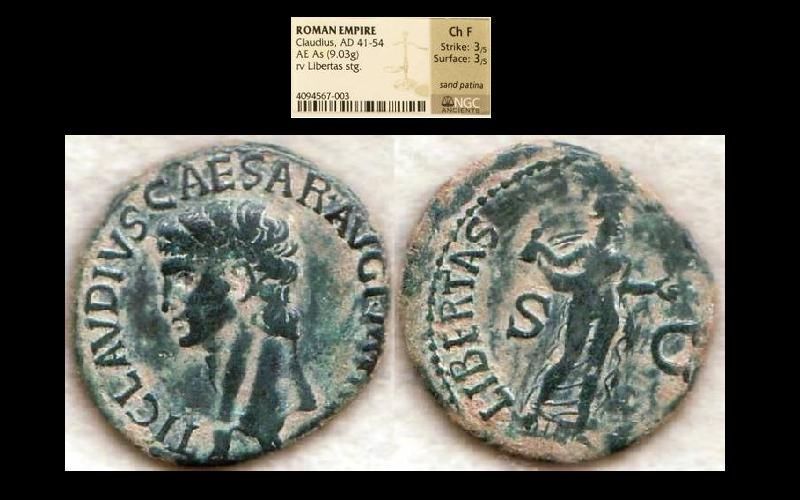

NGC cert verification page
Coins of Claudius (Wildwinds reference)
Wikipedia links:
Claudius
As (Roman coin)
Libertas
I, Claudius (book)
Roman conquest of Britain
As of the last edit, this coin was part of my "Eclectic Box of 20" collection.
It was originally part of my "Twelve Caesars" Roman collection.
Calabria, Taras- silver obol, ca. 250 BC.
(My cost: $65.60) - because the seller gave me a discount- it was originally priced at $82.00, as I recall.
Obverse- kantharos, surrounded by (five) pellets.
Reverse- kantharos, surrounded by pellets.
11 mm, 0.4 g. Ex-Brian Bucklan (bargainbinancients.com), 5/22/2014.
With cabinet toning from an old collection.

Coins of Calabria, Taras (Wildwinds)
Wikipedia links:
Taras (Tarentum, Taranto)
Kantharos (cantharus)
Kingdom of Macedon: bronze unit of Phillip II, ca. 359-336 BC
(My cost: $77.69) - 50 Euros plus shipping at the time
Obverse: head of Apollo right. Reverse: youth on horseback. Philip II was the father of Alexander the Great. Like the Akragas "crab" below, I bought this coin from Gitbud-Naumann in Germany back in May. Unfortunately G&N has deleted their listing and I never got around to looking up the attribution and doing a writeup for this. However, I used to own a very similar coin, albeit not as nice as this one, which has superior patina and eye appeal.

Ancient Greece: Seleucid Kingdom, bronze AE19 of Antiochus VIII, ca. 121-96 BC
(My cost: $110.00) - after slabbing
Obverse: radiate and diademed head of Antiochus VIII right.
Reverse: eagle standing left on thunderbolt, lotus-tipped scepter under right wing.
Struck ca. 121-120 BC, Antioch mint. 18.9 mm, 5.5-6.0 g approx. NGC VF (Strike 5/5, Surface 4/5, "sand patina"), cert.# 4094568-006. Ex-FORVM Ancient Coins, Lot# GB57125, July 2012. Purchased raw.
I love Seleucid coins for their combination of history, attractive designs, and relative affordability. The bronzes are often found with nice earthen or "desert" patina, and this coin in particular has very appealing patina with contrast to set off the design elements.


Original seller page
NGC cert verification page
Coins of Seleucia, Antiochus VIII (Wildwinds reference)
Wikipedia links:
Seleucid Empire
Antiochus VIII Grypus
Antioch on the Orontes
When posted here, this coin was part of my "Eclectic Box of 20" collection.
Sicily, Akragas: silver hemidrachm, ca. 410-406 BC
(My cost: $145.88) - 110 Euros plus shipping at the time
Obverse- eagle right, clutching dead hare in its talons, barley grain behind.
Reverse- Crab, with ketos below, swimming left with fish in its jaws.
16 mm, 1.8 g. SNG ANS 1012. Ex-Gitbud-Naumann, Germany, through VCoins store, 5/28/2014.
Eagles and hares! Crabs and sea monsters! Predators and prey! There is a lot going on with this wonderful ancient. I have always loved the Akragas "crabs" but can't afford one of the pricey big tetradrachms. And I actually like the design elements on this one more than some of those.

Slightly larger picture (900x450)
Coins of Sicily, Akragas (Wildwinds)
Wikipedia pages
Akragas (Agrigentum, Agrigento)
Ketos (cetus)
Troas, Birtytis: bronze AE8, ca. 300 BC
(My cost: $26.00) - and if you search these, I think you will find this was very cheap!
Obverse: bearded head of Kabeiros right, wearing conical hat.
Reverse: B-I/P-Y around club, all surrounded by laurel wreath.
8 mm, 1.1 g. Sandy/earthen patina. Ex- Andreas Reich ("areich" on FORVM ancient coins boards), Berlin, Germany. Sold to and later repurchased from "bronzemat" (Collectors Universe), 5/20/2014.
Birytis' precise location in Western Asia Minor is uncertain, but it probably stood either south of Troy or near the Hellespont (Dardanelles). Thus far, coins are the only surviving evidence of this city's existence.

Coins of Troas, Birtytis (Wildwinds page)
Wikipedia links:
Troas (the Troad)
Kabeiros (the Cabeiri)
The following three came in a swap I did with NiceCurrency back in May. I never got around to researching or reimaging them. So the italicized quotes were copied and pasted from his descriptions at the time. We pulled the prices out of thin air, so being somewhat new to Greek coins, I don't know how they relate to the real market, but they seemed fair to me, particularly as ours was a straight swap with no cash involved. The Lydian siglos and the Aigina sea turtle are both very popular, very archaic coins of historical significance, I know that much. And even crude Aigina Turtles don't come cheap- they're usually several hundred dollars even when the coin is a blob with no head or fins on the turtle. This example is slightly porous, but the turtle's head and appendages are all there. So the price might have actually been pretty good; who knows.
Sardis, Lydia: silver siglos
(My cost: $100.00 in trade)


Quote from NiceCurrency:
<< <i>here is my info on a similar Sardis, Lydia siglos
Achaemenid (First Persian) Empire
AR Siglos
Sardis (Sart, Turkey) mint circa 490/480-475BC
14mm
5.37g
Obverse: Kneeling-running figure of the Great King (either Darius I or Xerxes I) facing right, transverse spear with point downward in right, bow in left, bearded, crowned.
Reverse: irregular oblong punch
This coin was possibly introduced in connection with the accession of Xerxes. (These are lighter in weight, but all Achaemenid sigloi have a very similar design)
Reference: Carradice Type IIIa >>
Aigina: silver "sea turtle" stater, the first European coin
(My cost: $300.00 in trade)



Quote from NiceCurrency:
<< <i>the turtle stater from aigina is one of the first ones as initially they depicted a sea turtle and then started to put some dots on it that weren't seen on the real animal, and then later when athens kicked their ass they went with the land tortoise
this is generally believed to be the first european coin, the first coin of course coming from modern day turkey >>
Istros, Thrace: silver drachm
(My cost; $100.00 in trade)


Quote from NiceCurrency:
<< <i>here is a copy and paste of my info on that thrace two headed deal, this was of a diobol, but same general idea on the drachm
Greek City of Istros, Thrace (Istria, Romania)
AR Diobol
Istros mint circa 400-350BC
10mm
0.8g
Obverse: Two facing male heads, one inverted
Reverse: Sea-eagle grasping a dolphin with its talons, IÓTPIH above (my guess is this translates to 'of the Istrosians' but I'm not certain) >>
And we'll wrap things up with a Roman. And a nicely patinated one at that. You can often find this great "desert" patina on Eastern mint coins from the Late Empire, but one doesn't see it so often on First century pieces of the Twelve Caesars era.
Ancient Rome (Imperial): bronze as of Claudius, ca. 41-54 AD
(My cost: $140.00) - after slabbing
Obverse- TI CLAVDIVS CAESAR AVG P M TR P IMP P P, bare head left.
Reverse- LIBERTAS AVGVSTA/ S-C, Libertas standing facing with pileus, extending left hand.
RIC 113, 28 mm, 9.03 g. NGC Choice Fine (Strike 3/5, Surface 3/5, "sand patina"), cert. #4094567-003. Ex-eBay, July 2011, purchased raw.
Claudius is known for leading the invasion of Britain in 43 AD. He is an interesting character. Probably much of that has to do with his fictionalization in Robert Graves' 1934 novel I, Claudius, which was later made into an excellent BBC television adaptation in 1976. I can remember watching the show then (I had just begun collecting coins), but a lot of it went over my young head at the time, as I had no knowledge of Roman history. I'd love to rewatch those shows now, and the newer HBO adaptation, if it has been released.
I've always liked "sandy" or "desert" patina on late Roman coins from the eastern empire, but have hardly ever seen it on earlier Imperial coins like this. I've forgotten who I bought this from, though I think it was off eBay. I saved some partial notes, though unfortunately they didn't include the seller's name or the exact cost. I do remember being happy with the price. As I recall, the seller said this coin was struck at Tarraco in Spain, circa 50-54 AD.


NGC cert verification page
Coins of Claudius (Wildwinds reference)
Wikipedia links:
Claudius
As (Roman coin)
Libertas
I, Claudius (book)
Roman conquest of Britain
As of the last edit, this coin was part of my "Eclectic Box of 20" collection.
It was originally part of my "Twelve Caesars" Roman collection.
Collector since 1976. On the CU forums here since 2001.
0